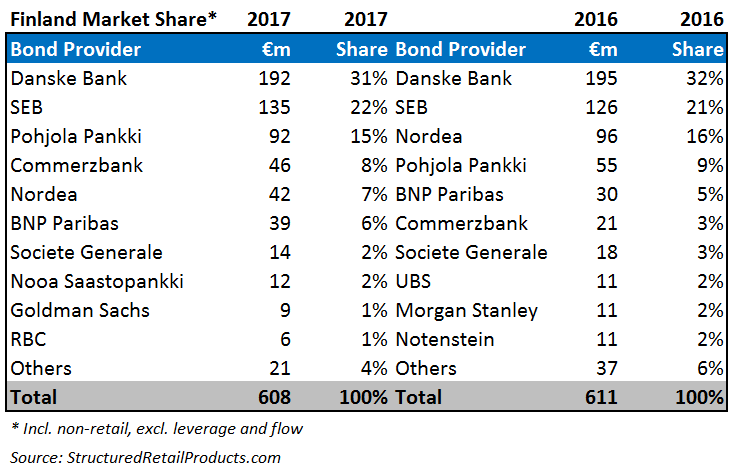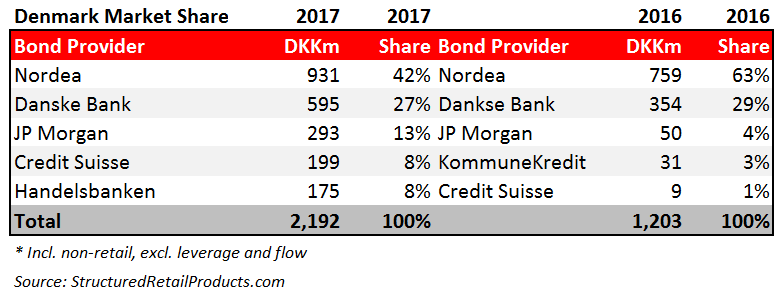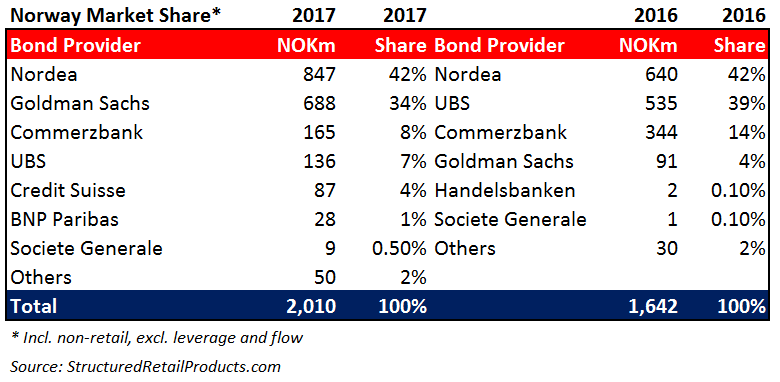2017 brought mixed fortunes to the four Nordic markets covered by SRP. In Sweden volumes were down by 24%, mainly due to Nordea, market leader in 2016, reporting a 63% drop in sales. In Finland sales were stable on the previous year although issuance was down by 18% while in Norway and especially Denmark, the market blossomed and sales volumes increased by 22% and 82%, respectively.
SRP reviews the data and the financial results of the top five structured products manufacturers in the Nordics.
Swedbank's activity was limited to Sweden, where it was the number one provider with a share of 19% of the market in 2017, according to SRP data. The bank sold 122 structured products worth SEK2.6bn (€264m) between January 1 and December 31, down from 144 products with a volume of SEK3.5bn in 2016. The vast majority of Swedbank's offering was linked to equities, and included SEK629m worth of structured products with a sustainability profile, including SPAX Europa Hållbar (SEK78m), Global Hållbar (SEK121m) which were each issued six times, and Hållbar Horisont (SEK89) which was issued four times in 2017, according to the bank.
The bank issued a total of SEK181bn (2016: SEK160bn) in long-term debt instruments to diversify its funding. The majority of the issues were covered bonds, though also in the form of uncovered bonds, where a new funding programme was introduced primarily for US investors. Outstanding short-term funding, commercial paper and certificates of deposit included in debt securities in issue amounted to SEK150bn as of December 31, according to the bank.

Handelsbanken was the second most prolific provider in Sweden, with a market share of 15% from 105 structured products worth SEK2.1bn, up from 75 products with combined sales of SEK1.7bn in 2016. The bank, whose products were distributed via Garantum, Skandia, Strukturinvest, Erik Penser and Consensus Asset Management, was also responsible for the best-selling product in Sweden in 2017 which came in the shape of Kreditcertifikat Norden SHBC STE11 and sold SEK238m during its subscription period.
Handelsbanken was also active in Denmark where it was the issuing party behind two private placement products from Jyske Bank (DKK175m/€23.5m).
During the year, new savings in the bank's mutual funds in Sweden amounted to SEK22bn, corresponding to a market share of 19.5%. The total fund volume, including exchange-traded funds (ETFs), increased by 17% from the beginning of the year to SEK498bn (2016: SEK425bn). Total assets under management in the group rose during the same period by 13% to SEK612bn (2016: SEK542bn). Handelsbanken's bond issues during the year decreased to SEK163bn consisting of SEK138bn in covered bonds and SEK22bn in senior bonds.
Danske Bank came third in Sweden (10% market share) where it sold 91 products with a volume of SEK1.4bn (2016: 68 products worth SEK1.2bn). In Finland, Danske, with a 31% share of the market, was the top provider, selling 81 products with combined sales of €192m - distributed, among other via Alexandria, Evli, FIM, Garantum and UB - level on 2016 when 80 products worth €195m were sold. In Denmark, the bank's domestic market, Danske sold DKK595m from 13 products (2016: DKK354m from five products) including Eurostoxx Banks Sprinter 2017 which collected sales of DKK143m.
Danske reported in 2017, issuance of covered bonds, senior bonds and additional tier 1 capital totalled DKK67bn, against the funding plan of DKK55-70bn.

Nordea was active in Sweden, Finland, Denmark and Norway, albeit with contrasting fortunes. In Sweden the bank saw a year-on-year drop in sales of more than 60% (SEK1.3bn from 45 products compared to SEK3.6bn from 80 products in 2016) while in Finland, with a 56% decrease in sales (from €96m to €42m), the bank did not fare much better, according to SRP data. However, in Denmark and Norway, volumes were up by 42% and 32%, respectively.
Nordea reported €179bn debt securities in issue at the end of December 2017, down from €192bn at the end of 2016. The bank issued €1.3bn in long-term funding in the fourth quarter (excluding Danish covered bonds and subordinated notes), of which approximately €1.2bn represented issuance of Finnish, Swedish and Norwegian covered bonds in domestic and international markets. The long-term funding portion of total funding was approximately 81% at the end of December, according to the bank.

SEB was active in both Sweden and Finland. In Sweden the bank's sales, at SEK1.2bn, were level on the previous year, although they were achieved by a much lower number of products (72 in 2017 against 115 in 2016). The bank's offering included 31 credit-linked notes, making it the most active provider in this genre in Sweden. In Finland, where the bank came second behind Danske with a 22% share of the market, SEB's sales, at €135m (from 51 products) were slightly up from the previous year (2016: €126m from 67 products).
SEB reported the effect from structured products offered to the public for the fourth quarter of 2017 was approximately SEK5m (Q3 2017: SEK205m, Q4 2016: SEK535m) in equity-linked derivatives and a corresponding effect in debt-related derivatives SEK110m (Q3 2017: -SEK75m, Q4 2016: -SEK355m). Short-term funding in the form of commercial paper and certificates of deposit decreased by SEK44bn from year-end 2016. SEK87bn of long-term funding matured during 2017 (of which SEK47bn covered bonds, SEK28bn senior debt and SEK12bn subordinated debt). During the year new issues amounted to SEK80bn (of which SEK55bn constituted covered bonds, SEK20bn senior debt and SEK5bn additional tier 1 subordinated debt). SEB's inaugural own green bond in the amount of €500m was part of the senior funding raised.

'As we close the books on 2017 we can conclude that the macroeconomic sentiment - and thereby business sentiment - has grown more positive,' said Johan Torgeby (pictured) president and chief executive officer, SEB, in a statement. 'Spurred by more jobs, higher asset prices and higher investment levels as well as increased trade, the world economy is gearing up despite heightened geopolitical uncertainty [...] as part of the implementation of the new Mifid regulation, we enhanced our offering to private banking customers. Assets under management increased by SEK80bn to SEK1,830bn.'
Click the link to view the full year 2017 report for Danske Bank, Handelsbanken, Nordea, SEB and Swedbank.
Related stories:
It is a fine balance between the innovative complexity and desired simplicity, Nordea
Strukturinvest expands investment solutions range with credit hedge fund products